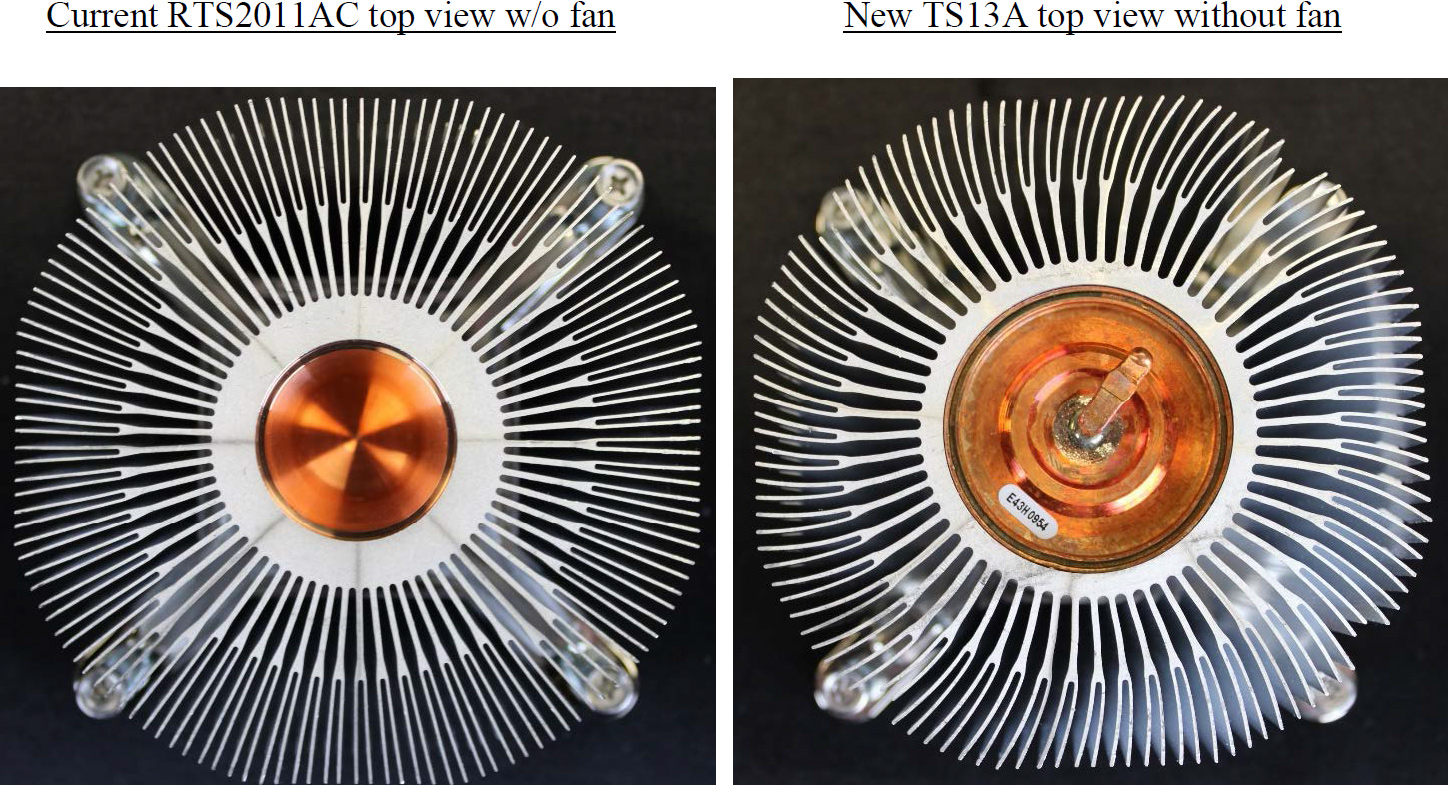Intel's Haswell-E Boxed Cooler is a Wee Bit Bigger
Intel's new boxed cooler will be a little bigger and a little more powerful.
The Haswell-E processors from Intel are expected to arrive sometime in September, with the three chips in question being the Core i7-5820K, the Core i7-5930K, and the most extreme Core i7-5960X. These chips are six-core and eight-core parts and will have TDPs of 140 W. That's a lot of heat to dissipate, and for that reason, Intel is demonstrating a new boxed CPU cooler – the TS13A.
The TS13A replaces the older RTS2011AC and should offer a little more cooling power. Both of the coolers look very much alike but do have some subtle differences. For instance, the fins are now curved sideways, and the internal copper core has been replaced with a heat column, which is essentially a large heat pipe. Of course, the most obvious difference shouldn't be forgotten; the height of the unit is 12 mm taller than its predecessor, making it 75 mm tall.
Now, while the new cooler will be more powerful, we don't expect that many enthusiasts interested in a Haswell-E chip will end up using the boxed cooler. Most DIY builders will probably simply replace them for much more powerful units. Despite that, a new, more powerful cooler like this is still necessary because not every Haswell-E chip will be used by enthusiasts – there are plenty of OEMs that stick to using the boxed Intel cooler. While the old cooler might have been able to cool the chips adequately, a bigger cooler does raise the threshold for thermal throttling, essentially minimizing the performance penalty in OEM builds.
Reportedly, the new cooler will not only be shipping with Haswell-E processors, but also current socket LGA2011 chips, as of August 29.
Follow Niels Broekhuijsen @NBroekhuijsen. Follow us @tomshardware, on Facebook and on Google+.
Get Tom's Hardware's best news and in-depth reviews, straight to your inbox.
Niels Broekhuijsen is a Contributing Writer for Tom's Hardware US. He reviews cases, water cooling and pc builds.
-
Someone Somewhere This is the boxed cooler that is not, in fact, included in the box with any CPUs?Reply -
dgingeri My SB-E didn't come with a cooler, and last I heard the IB-E didn't either. Where is this older cooler coming from?Reply -
Someone Somewhere It's available separately for those who want it. I suspect they don't sell many.Reply -
snarfies A total waste. Anyone buying the Haswell-E is going to buy their own, more effective, heatsink.Reply -
lp231 KitGuru already posted a article on it way earlier, but it didn't comes up on Google Search unless you look under the News section. Tom's should have a submit news section, so anything interesting can be posted on the front page.Reply
I kind of disagree with that because us enthusiast who knows to get a better HSF is probably like 1%. The rest are OEM and Intel can sell it to them and that is a lot.13895598 said:It's available separately for those who want it. I suspect they don't sell many.
-
WithoutWeakness It's likely an optional cooler offered to OEM's, None of the SB-E or IVB-E chips came with boxed coolers.Reply -
velocityg4 ReplyI kind of disagree with that because us enthusiast who knows to get a better HSF is probably like 1%. The rest are OEM and Intel can sell it to them and that is a lot.
This mentions it is for K series and X series chips socket 2011. Large OEM's don't sell many of these usually it is smaller builders like Falcon Northwest, computer shops and IT people. As these are mainly enthusiasts parts the split is likely closer to 50/50. Since the average enthusiast has the knowledge to build their own PC.
Professionals who need workstations and servers with 6+ core socket 2011 chips are going to be going with Xeon. The socket 2011 Core series is almost exclusively for enthusiasts that want Xeon power but don't need the Workstation features like ECC memory. -
mapesdhs ReplyProfessionals who need workstations and servers with 6+ core socket 2011 chips are going to be going with Xeon. ...
Except for the solo professionals who can't afford XEONs; for them, an oc'd K/X
i7 is an excellent compromise (I've built several for this type of user), a stepping
stone on the way to something more powerful once they've earned enough to
jump to a 2-socket XEON. An oc'd K is about the same speed as one 10-core
XEON, so it needs a 2-socket board to be worth the uprade expense, a build
which will be about 3K higher than an oc'd i7.
Ian.
-
dgingeri The old one apparently couldn't even handle keeping a 3930k below 80C under a medium load. It was only around $25, too. I doubt this would one do any better.Reply



